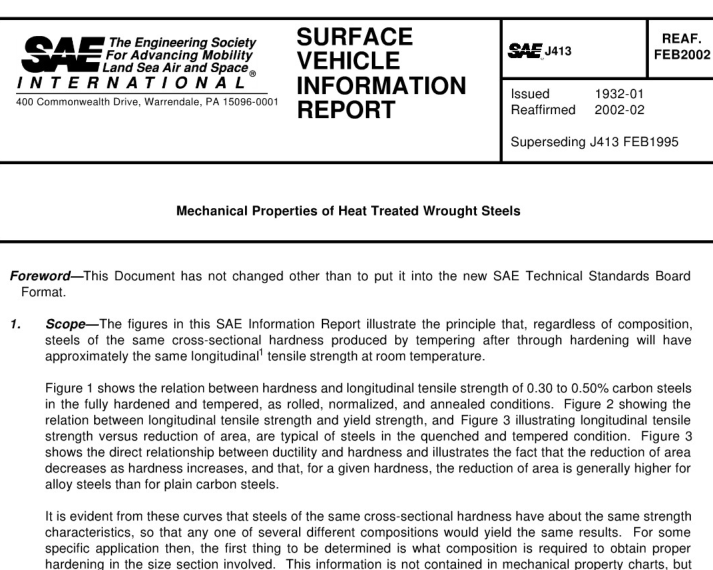SAE J413:2002 pdf download Mechanical Properties of Heat Treated Wrought Steels
1. Scope—The figures in this SAE Information Report illustrate the principle that, regardless of composition,steels of the same cross-sectional hardness produced by tempering after through hardening will haveapproximately the same longitudinal’ tensile strength at room temperature.
Figure 1 shows the relation between hardness and longitudinal tensile strength of 0.30 to 0.50% carbon steelsin the fully hardened and tempered, as rolled, normalized,and annealed conditions. Figure 2 showing therelation between longitudinal tensile strength and yield strength, and Figure 3 illustrating longitudinal tensilestrength versus reduction of area,are typical of steels in the quenched and tempered condition. Figure 3shows the direct relationship between ductility and hardness and illustrates the fact that the reduction of areadecreases as hardness increases, and that, for a given hardness, the reduction of area is generally higher foralloy steels than for plain carbon steels.
lt is evident from these curves that steels of the same cross-sectional hardness have about the same strengthcharacteristics, so that any one of several different compositions would yield the same results. For somespecific application then, the first thing to be determined is what composition is required to obtain properhardening in the size section involved. This information is not contained in mechanical property charts, butcan be determined from published data or by means of a hardenability test. Methods of making thishardenability test and interpretation of the test results are provided in SAE J406b.
Having selected a steel that will through harden in the size section under consideration, the engineer mustdecide from the service stresses imposed on the finished part what tensile properties are required in the part.These tensile properties may then be converted to hardness values from the figures given here; and fromFigure 4 showing the effect of tempering temperature on hardness, the appropriate tempering temperature toobtain this hardness can be selected. in Figure 4 the curves are approximate values to be used as a guide.Carbon steels and lean alloy steels, when fully hardened, will fall slightly below the curves and strongly alloyedsteels will fall slightly above the curves.
Figure 4 showing the effect of tempering temperature on hardness is a summary of information contained in alarge number of mechanical property charts published by steel companies, alloy suppliers, and users. Thesecharts represent, as do the charts on tensile, yield strengths,and reduction of area, data on all SAE alloy andcarbon steels with carbon contents of 0.30 to 0.50%.
Mechanical property values obtained from these few summary figures will be as accurate as the informationformerly available in a large number of charts, each representing an individual type of steel. For more exactinformation it would be necessary to make tests on samples from individual heats of steel.
SAE J413:2002 pdf download
